A day in Topslip, Anamalai Tiger Reserve
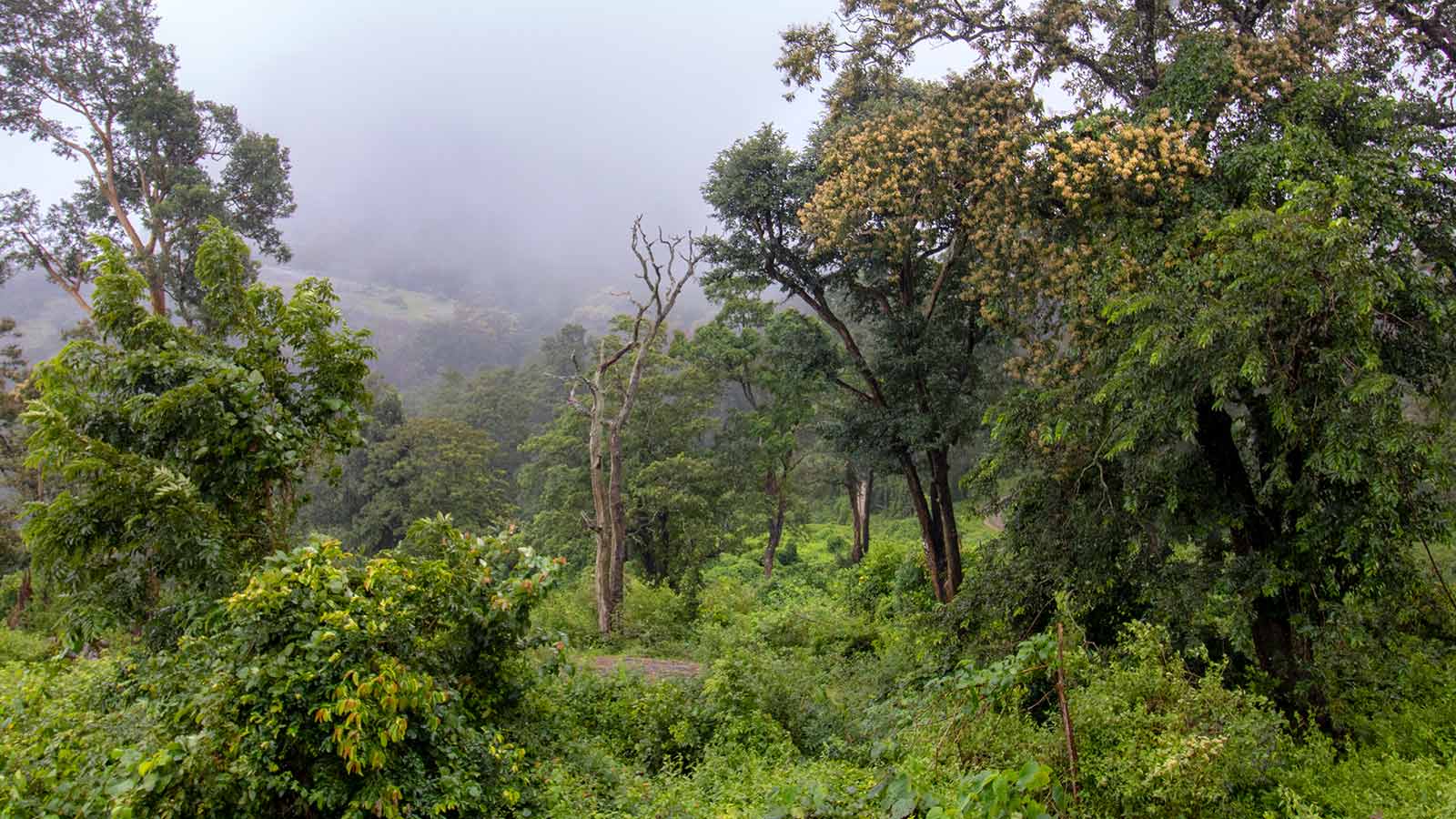
Parambikulam Tiger Reserve was our favorite forest destination when we started travelling. We visited the reserve frequently and trekked in all possible routes. After a while we started exploring other locations in the world and travelled to a wide variety of places. So we didn’t get a chance to visit Parambikulam for many years. Recently we read a Cornell Lab report on decrease in bird population and it was alarming to see the decline in numbers. We ourselves noticed very less number of birds during migratory season. Out of curiosity, we posted this detail in Sanctuary Asia Facebook Page and asked them were there any numbers available for India. Sadly, the FB Group did not even approve our post. It was really frustrating when the so called nature enthusiasts were not even trying to acknowledge the current deteriorating situation in natural world. It was like a taboo to talk about the destruction in natural world even among nature lovers. Everyone just wanted to take beautiful photographs of birds and post in facebook.
When we can’t even discuss fall in bird numbers with nature enthusiasts then what chance do we have to protect them?
So we both had a constant nagging sensation about the natural world around us while the city life around us continued normally. We decided to visit our “Old is Gold” Parambikulam Tiger Reserve and see how it got changed in the recent years. But we were bit upset to see the Reserve is more or like a resort now. So we decided to go to Topslip Aanamalai Tiger Reserve.
We went to the reserve during peak monsoon season. So we were prepared for full day rain and started our trip. As expected we drove through the rain and all the bridges we crossed had so much water running underneath it, which was not a common sight in India. In one of those bridges I spotted a patient onlooker, the Stork-billed Kingfisher who was calmly watching the river running below him.
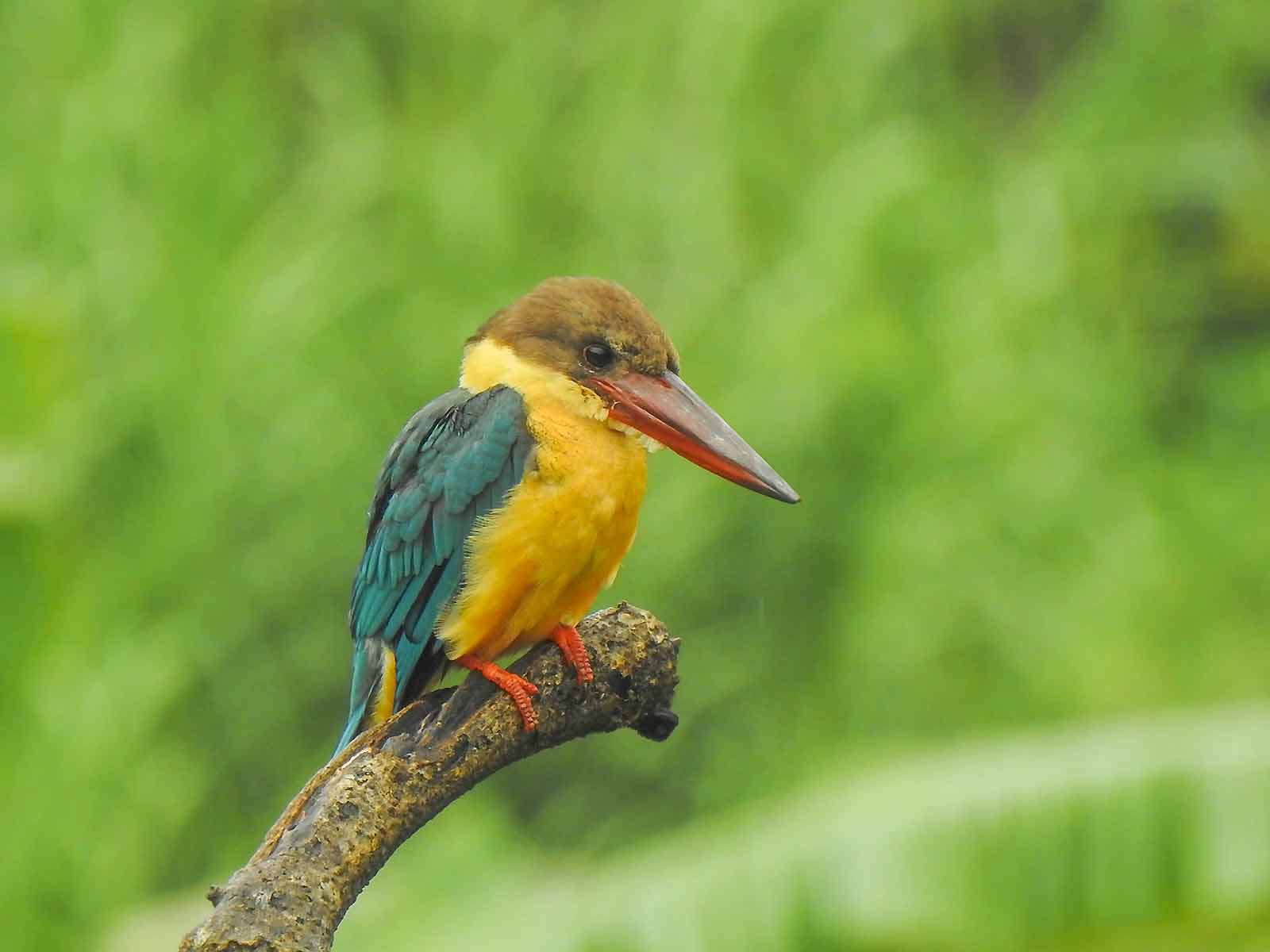
The Stork-billed kingfisher is a large kingfisher. Despite its size the bird cannot be easily spotted as it silently perches on some stick without seeking much attention. It is territorial and will chase away eagles and other large predators.
The bird didn’t mind us at all, so we happily watched him in the beautiful drizzle. When we were close to Sethumadai , we were happy to see the road side trees had grown well. In recent years it is a normal sight to see all the trees cut down on the roadsides. So even this simple sight of roadside trees made us very happy. We enjoyed the drizzling weather and stopped near a farm to have our homemade idly. We watched the clouds moving above the Western Ghats and had our breakfast. There were just few Grass Yellow butterflies flying around and no other activities because of the dull weather.
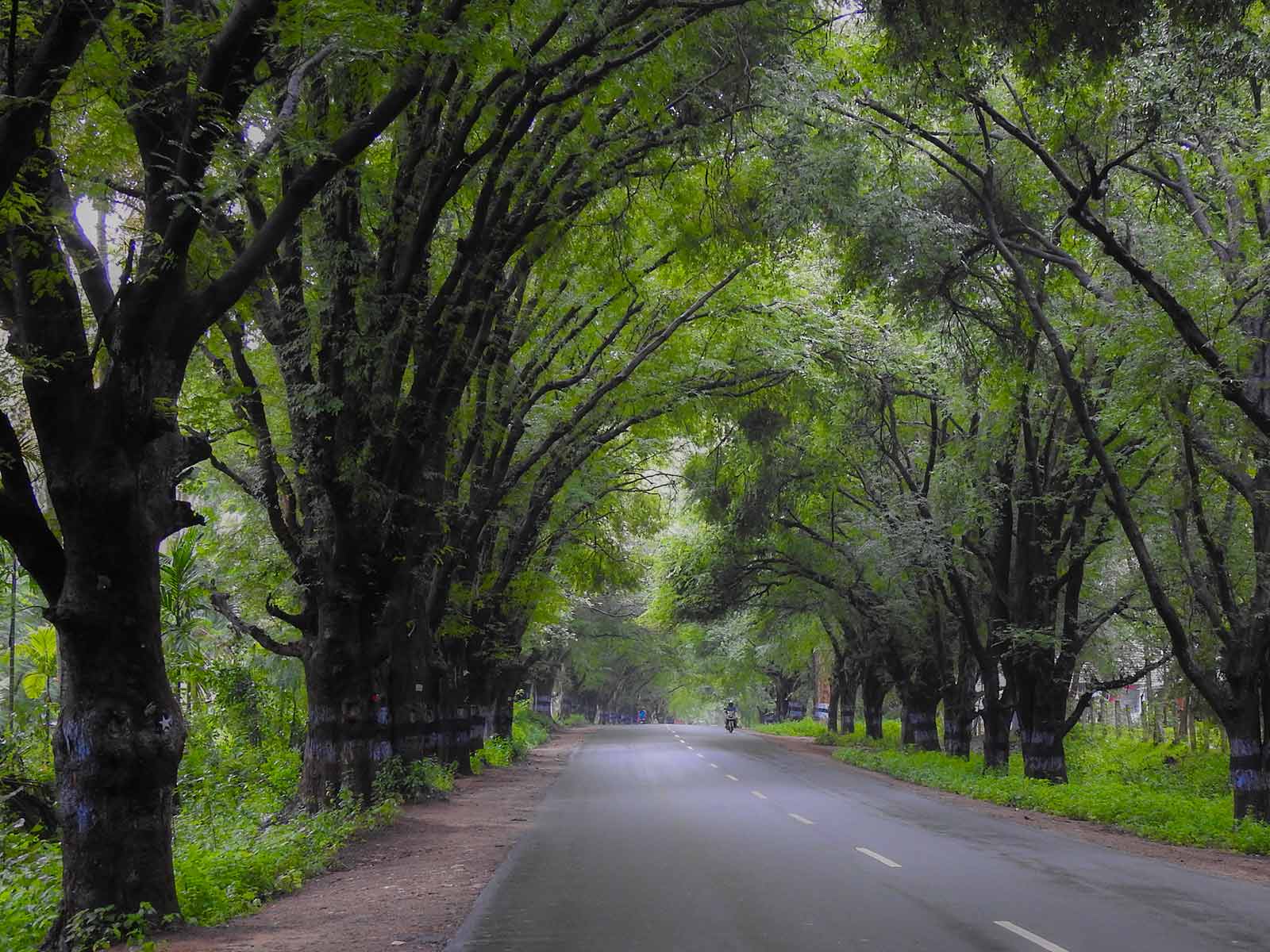
Vinod and myself always love the roads with huge trees. So it is very disheartening to see the trees cut down as part of widening roads. If only all the roads in India look like this, should we really have to worry about pollution ?
Once we entered the forest zone , the aura suddenly changed. The forest was teeming with bird and butterfly activities as if there was some magical border between the forest and the village. Even though it felt like we entered into a magical world, the real reason for the diverse wildlife is the diverse varieties of plants inside the forest. The Gymnosperms and Angiosperms inside the protected reserve were totally different from the ones found in the farmlands outside the border. So the life inside the forest can never be compared with the wildlife amidst civilization. The forest changes with season, so every time we visit a forest there is always substantial difference. What I am trying to say is, it is not like watching the same movie again and again. Even though we had visited Anamalai Tiger Reserve many times, that was the first time we had seen Leonotis nepetifolia (Lion’s Ear) in full bloom. The Purple-rumped sunbirds, flower peckers, Orange-tip butterflies, Emigrant butterflies, Pioneer butterflies etc were fluttering with joy on the orange flowers of Lion’s Ear.
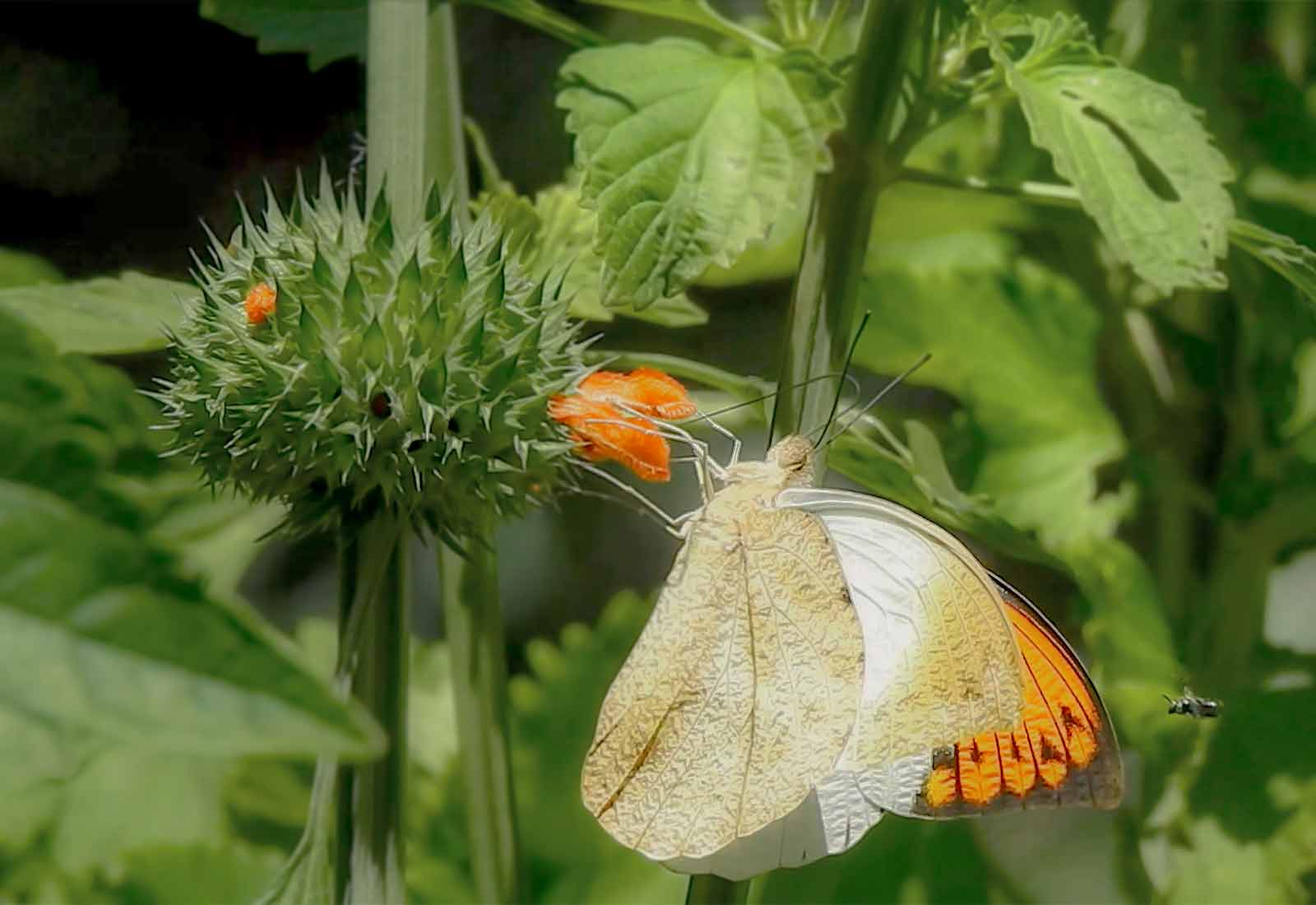
The Orange-tip butterfly was clinging to the Lion’s ear flower and a bee was trying to chase off the butterfly. There was heavy competition for this tiny orange flower. The Orange butterfly on the Orange flower made the scene more enthralling!
We drove very slowly to watch these colorful fluttering beauties and the vehicles which crossed us were in serious doubt whether we had spotted any big mammals. When we pointed out the butterflies and birds, the so called wildlife lovers were very disappointed. The tourists always think that there is a queue of wild animals which they can see immediately entering inside the forest zone. I am just glad that our forests are so dense that we can never arrange Tiger Safaris like in Central India and cause stress to wild animals. As we drove very slowly, it took more than 1 hour to reach the reservation counter which was just 11 kms away from the check post. Still we were very early and the officer told us to roam around casually. The air was chilly and the forest officials were lazily walking around as there were not many tourists.
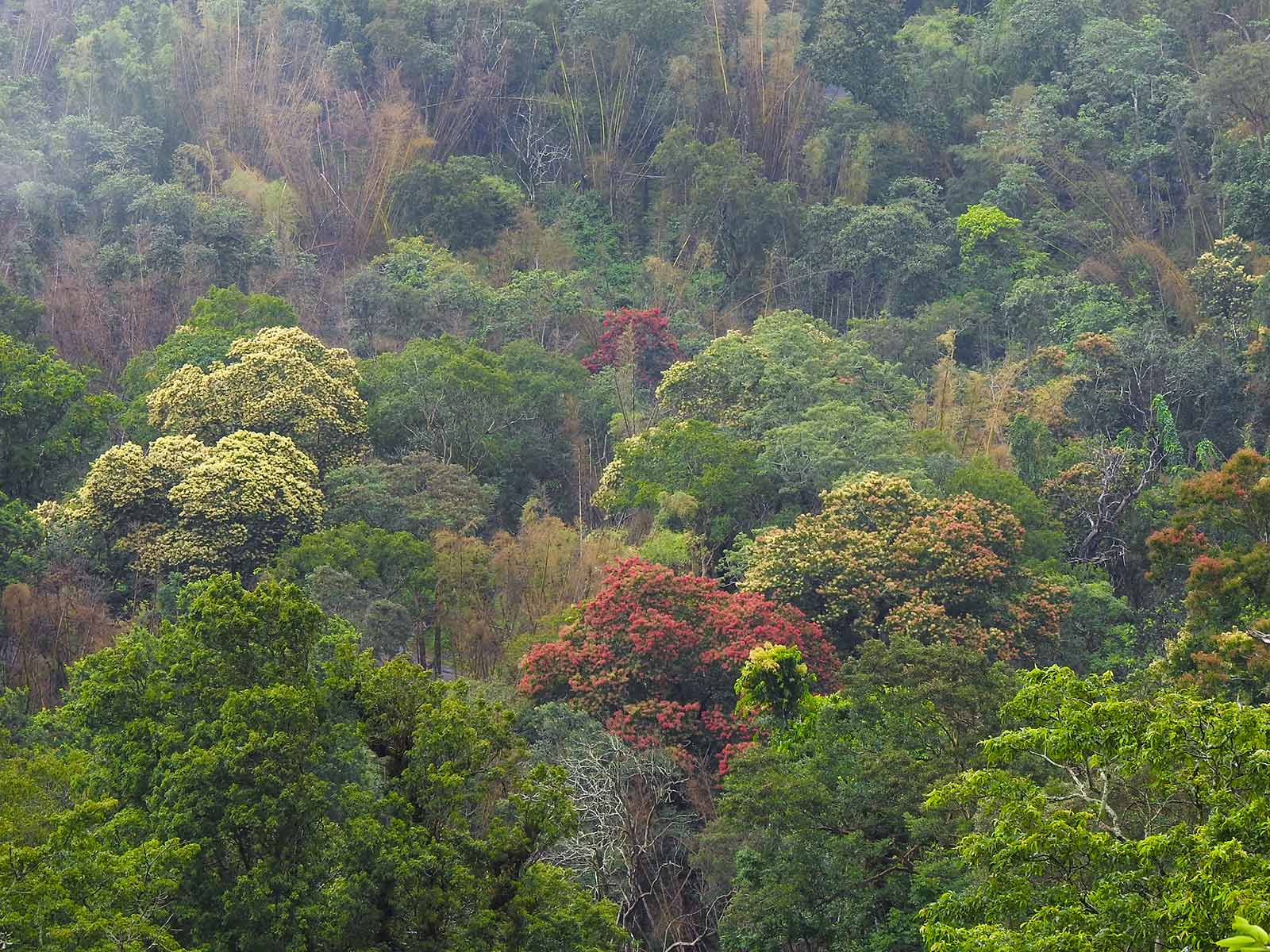
Autumn color makes everyone to think about the fall leaf colors in Western countries. How many of us know that in India, the forest is as colorful as the Western countries. Infact, more colorful as these colors are not from dying leaves but from the flowers, seed pods and young leaves.
So we decided to drive till Parambikulam Tiger Reserve. Within few minutes, we saw a herd of Spotted deer. They were not scared of us but had a cautious look. While we were watching them, the Jungle babblers were making such a racket jumping on the bamboo culms. A jeep rushed past us and reversed to come near us. Usually in tiger reserve we were not allowed to get down from our vehicle. We were near the forest office, so we just got down thinking there won’t be any issue. But seeing the jeep stopping near us, I thought we were in serious trouble. Then we saw the person who got down from the vehicle and we were awestruck. It was Shaju from Parambikulam and he was the one who accompanied us as guide in our past Parambikulam trips. We were all budding nature enthusiasts at that time and learnt a lot from each other. He had taken us to various treks and one of that was the amazing Karimala trek. We had lost touch in the subsequent years and so we were very thrilled to see him after these many years. I was very surprised that he remembered us on the first sight and that indirectly meant we both didn’t change much in these past years (“Wink, wink”).
After good talk with him we continued our drive towards Parambikulam. We just stopped near the Parambikulam forest entrance gate and sauntered around. There was a flock of peafowls who were casually roaming around.

The peafowls are quite a common bird in South India but that never stopped us from admiring their beauty. But this scene looked quite comical when everyone of the flock followed some hierarchy and stood in a line.
We watched the peafowls pecking on the ground with so much concentration and laughed at the adult peacock who was trying to show off with his small feathers. Very few tourists came around and they too returned back as the safari trips were cancelled on account of weather. We spotted few caterpillars and just tried to identify them seeing their host plants. After few fun searches we decided to return back to Topslip. We reached our stay and were thrilled to see Quaker, Restricted Demon butterflies near the stay itself. We decided to quickly unpack our things in the room and come back to explore the wild beauties around us, but it seemed like Mother Nature had other plans and it started pouring heavily once we entered our room. So we just sat on the room and watched the rain from our windowsill.
Beautiful forest stay in Topslip

The windowsill was very comfortable for us to sit and watch the non-stop rain. If not for this windowsill the stay would have been boring. It was a great advantage point during birding as the birds didn’t mind us at all.
We expected this weather, so I had packed lots of food for this travel. We unwrapped our home made delicious fried rice and paneer masala. Watching the scenery in front of us, we had our food. After stomach full of food and cozy weather, the thing that immediately comes is sleep. I was very sleepy but then rain stopped and the birds started chirping joyously. I am the person who sleeps nicely even in a loud theatre but I never do that in a forest as there is always something interesting to see. Vinod took all his camera gears and myself with binocular set out to see the birds. As it is a tiger territory we could not wander alone, so we just restricted ourselves around the stay.

The sheer variety of trees are the key for a good forest. This old forest had huge varieties of tall trees and each tree was in different green shades after rain. In the direction I was looking at, there was Fascicled-Flower Balsam in full bloom.
A pair of grey wagtails were jumping around and eating the dead winged termites. Another flock of adult peafowls were wandering around the stay. The Nilgiri Langurs were making some loud calls and the forest was vibrating with that sound. Lesser Flameback was knocking the woods and a brown shrike was perching on a dead tree and keenly searching for his next prey. Vinod was sincerely taking videos of the birds for the Indian bird video project while I just sat and watched all these events in binocular. After this short interval, rain again started and didn’t stop till next morning. We just sat in the room and enjoyed the sound of rain. Vinod who is always a night owl got up in the middle of the night and saw few hares jumping around. Then he saw a bird which flew and sat on a tree nearby. His initial thought was a Scops Owl but then on a closer look it was the elusive Ceylon Frogmouth. Almost all the people who had seen a Frogmouth would have seen them just perching on a branch doing nothing.They sit so still that we even get a doubt whether they are alive or not. Vinod didn’t want to use flash to take a picture and disturb the bird who was actively hunting. He was just happy to see the bird in action. After few minutes, the bird flew away. The night life is always more vibrant in forests than in cities.
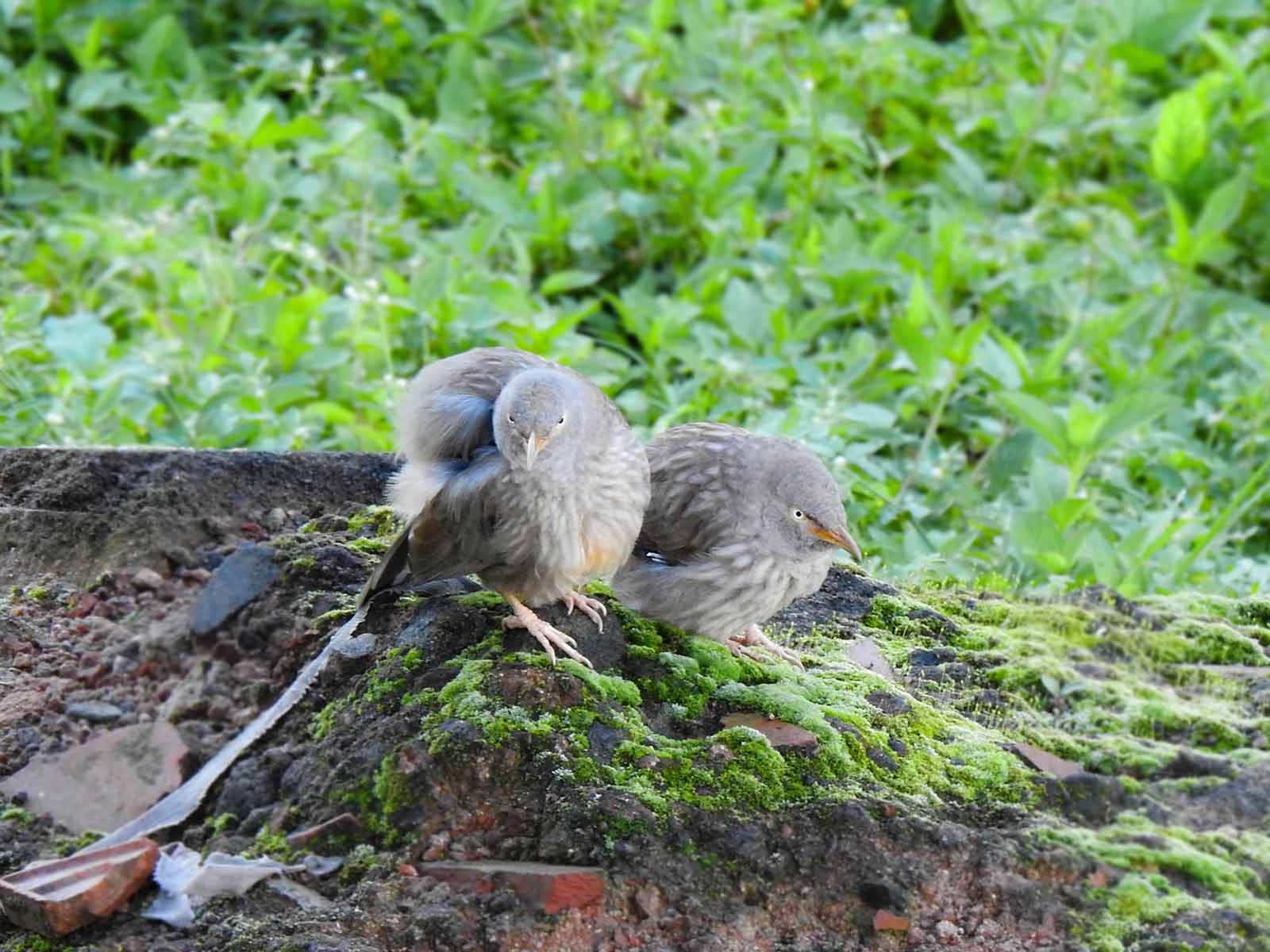
The babblers or seven sisters are always fun to watch. They are very noisy and highly energetic. Their body language is always intriguing. This Jungle babblers were making the place very alive by their constant movements.
The mornings after rains are always not to be missed. Sky, trees, birds, flowers will always be in different mood showing different colors. So we just sat and saw the colorful sunrise. The jungle babblers were pecking on the ground to eat the dead insects. Malabar parakeets were making quite a scene to eat the berries on a bush. Orange minivets were flying around. Small minivet was trying to catch insects on the flowers which made the rain drops on the flowers to shower on him. While all these birds were busy in the sunshine morning, Flame-throated bulbul was sitting silently on a tree. Few butterflies like Red Pierrot, Lemon Pansy started flying around. Then suddenly a very familiar wing flapping sound came nearby and there he was, our favorite Great Indian Hornbill. After Chinnakallar trip this was the first time we were seeing him in Western Ghats. We both were so excited to see him and he sat silently on a dead tree. While other birds were jumping around and lot was happening around us, our eyes were just on the Great Indian Hornbill.
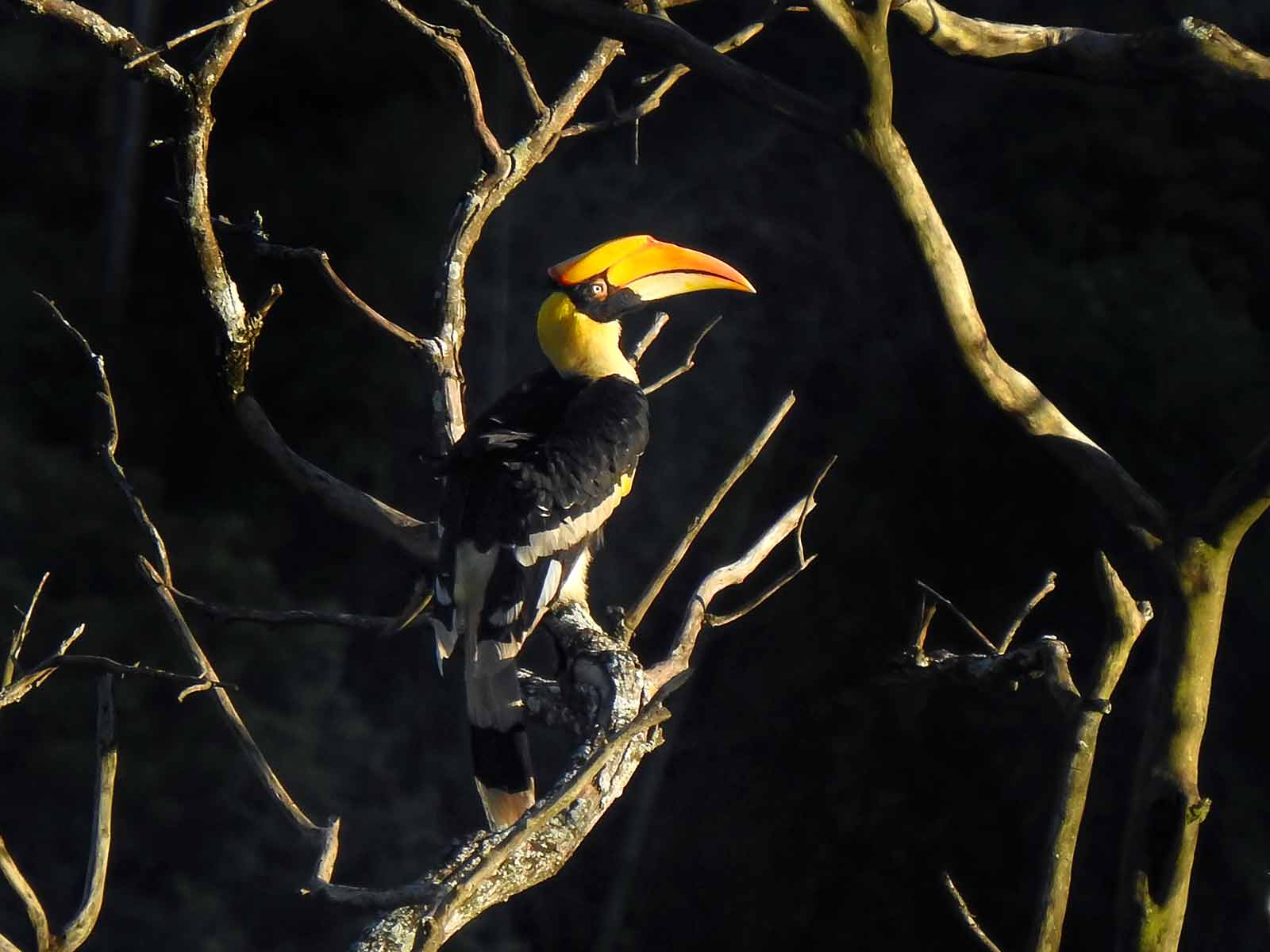
Great Indian Hornbill is impressive in size and colour. The Great hornbill is long-lived and is predominantly frugivorous. The pair make loud duets, beginning with a loud “kok” given about once a second by the male, to which the female joins in. They prefer mature forests for nesting.
We watched the Great Indian Hornbill till he flew back to his flock. With him departing, the nagging feel I had before the trip was slowly receding as I once again got a glimpse of biodiversity. But as much as I wanted to tell myself everything was alright, I know deep inside that something is wrong. I also felt helpless because I am unable to do anything about it, because environmental issues are a systemic problem with human civilization. But I know one thing for sure that if we leave the forest to the wildlife, they will take care of themselves. They don’t need any humans to protect them; they just don’t want any humans to destroy them. If we leave the land to the wild, the land will heal itself and start supporting biodiversity. We are not going to give all their original habitat back but at least inside the protected reserve they can establish their life if we don’t disturb them. So when I saw “a flock of ” Malabar Parakeets, “a pair of ” yellow-browed bulbul, “a bachelor” Brown Shrike, “a herd of ” spotted deers, “a drove of hares, “a family of” Brahminy Kite I knew they can come back if we give them their habitat back.
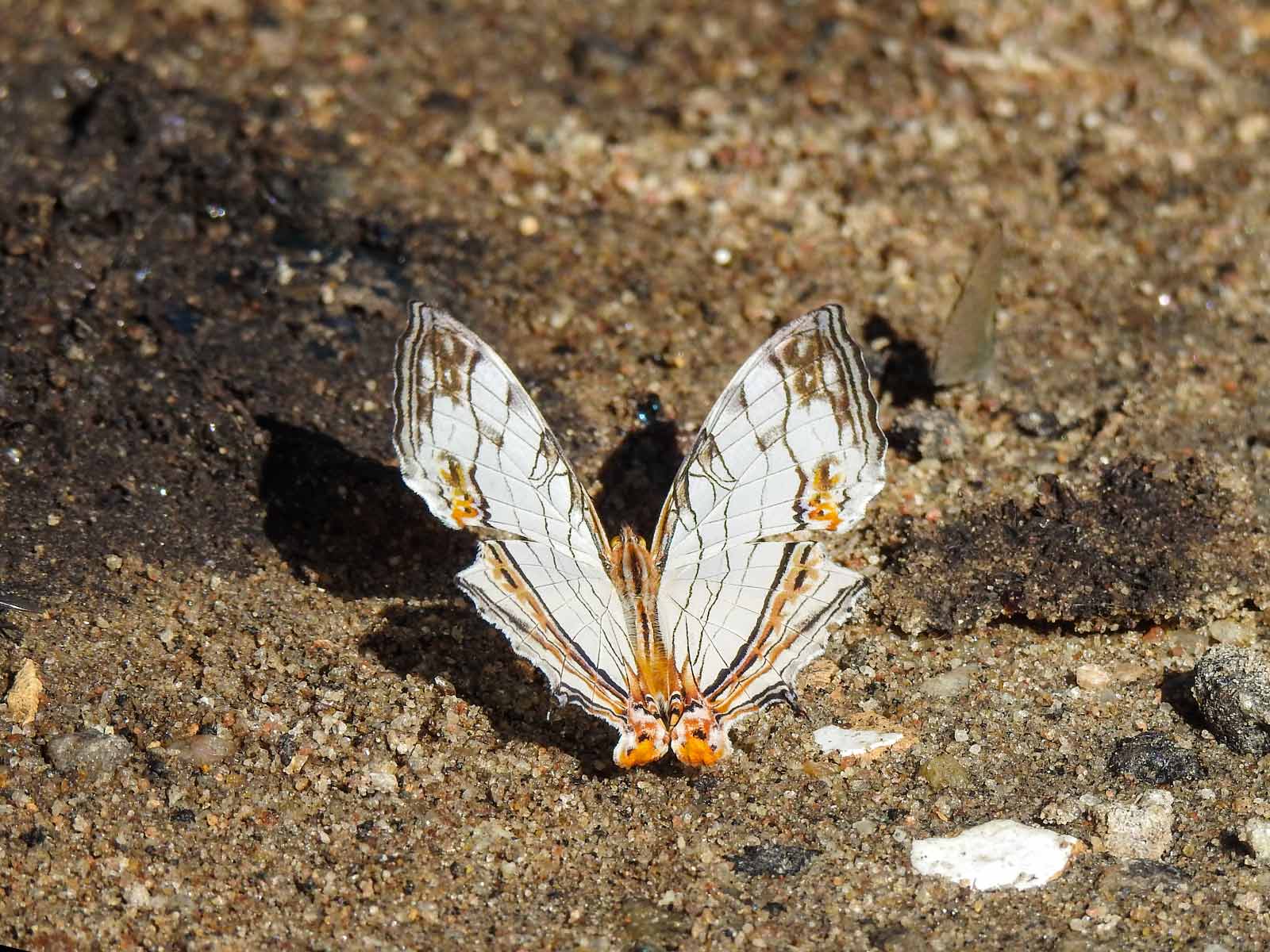
Common map butterfly is one of the butterflies with unique design and color combination. It is usually seen in dense forest. It has a slow flight and can be seen sitting with open wings on the roads inside the forest.
With those thoughts filling my head we started our way back. There was no rain and it started getting hot quickly. We drove back relaxed and at a snail’s pace as we had nature therapy. The return journey was not without any events but with lots of good sightings. We saw Common Map , Tamil Treebrown and Commander Butterflies on the forest road itself. There were lots of mud-puddling activities and the lizards were just lazily sitting on the rocks without even bothering to catch these butterflies. The Malabar barbets were having a feast on a fig tree with ripened fig fruits. The Hill mynas were talking with each other loudly.
While we were seeing these activities in forest and exiting out it was 11 A.M. One of the passing tourists asked us did we see any animals on the way. We just shook our head in despair, he would have thought that we were disappointed because we didn’t see any animals. But in truth we were disappointed on him. The people are just expecting a zoo instead of finding a connection between the forest and themselves.
Only in zoo you can find animals all the time because they are caged.
When they are roaming around in wild they have their own life to mind about. They have to build their home, find a mate, raise a family, search for food. So they are quite busy than us and they can’t just sit around on the roadside at 11 A.M. But somehow in the name of civilization we don’t want to understand them and always had to feel that we are the superior beings in the world.We both don’t have much hope for the natural world as they can’t compete with the constant increasing human greed. But seeing the forest alive and the wild beings in it living their life makes us happy for that particular moment. With that we bid adieu for the ever enchanting Western Ghats and entered back into civilization.